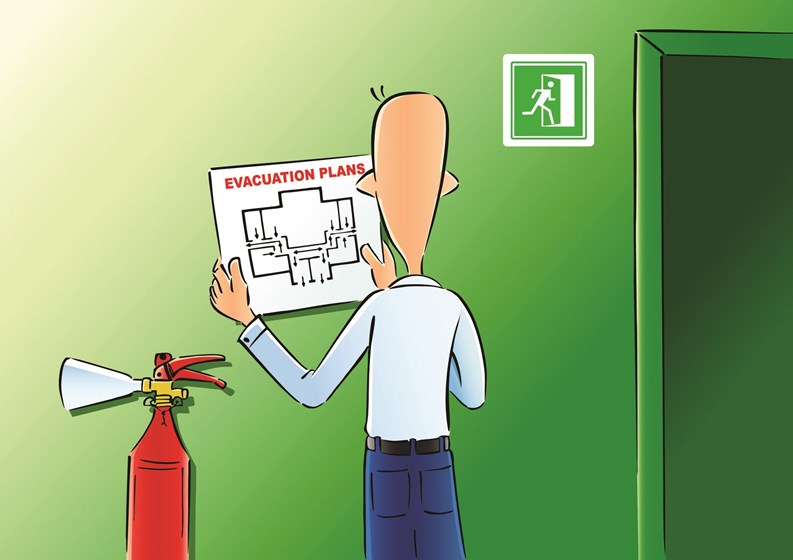Some days it rains, some days it pours – and some days, there’s a category 4 hurricane. And while the latter is relatively rare, it can be a true disaster, and any condominium, co-op or homeowner’s association worth its salt should be prepared for it. Whether storm, fire, earthquake or freak accident, a board must take into account anything that may confront its community and put property and personal safety in danger, and come up with a plan to best lead its constituents to safety. And while this seems like quite the undertaking, there are guidelines in place and experts on hand who can help steer an association through disaster preparedness.
The Roof is On Fire
While hurricanes are more common in Florida than elsewhere in the United States, nationwide data points to fires as being the most common cause for evacuation of residential properties. An association needs a firm policy in place for what to do in this type of stressful situation.
“The Red Cross responds to more than 60,000 home fires per year,” says Kevin F. Kelley, senior director of community preparedness programs for the American Red Cross. “Although they’re a little under the radar, they can happen in every community, and nationally they add up, so this is always a smart thing on which to work with residents. We have a campaign currently underway called 2 Steps 2 Minutes, and those two steps are basically to check your smoke alarms monthly and to practice home escape fire drills, where you try and get everyone out of the home in two minutes, as research indicates that it’s at that point where a person will be overcome by smoke and potentially killed.”
In condos and HOAs, there may be municipal codes or language in a community’s governing documents that speak to fire safety requirements, and a board should consult those accordingly and make sure that they are, at minimum, adhering to the law of the land. But as Kelley observes, “The general rules are to check the smoke alarms, make sure they’re working, and to practice a home fire escape drill that includes a meeting place that is well away from any potential fire. The reason being that when everyone gathers at the same place, no one – including firefighters – risks their lives trying to go into homes to rescue people who still may be inside. If the first responders know that they don’t need to undergo a search and rescue, they can just handle the suppression of the fire itself.”
The responsibility of making sure your property is up to code and that the alarms are working at full capacity isn’t always the board’s burden to shoulder; there’s professional help available. As Jeff Cooperman, a partner with Association Law Group in Miami points out, fire departments are often more than willing to come in and walk a property, inspecting systems themselves. “One of the most critical things that an association can do is to have the fire department come through and work with them on a plan,” Cooperman says. “The local fire department is always going to have the most – and most current – information.”
One issue to keep in mind is that, in Floridian condo communities especially, many residents do not stay in their units year-round. “You don’t know if Mrs. Johnson is in her apartment during an emergency, necessarily, if she doesn’t live there full time,” notes Richard D. DeBoest, II, a shareholder with Goede, Adamczyk, DeBoest & Cross PLLC which has offices in Naples, Miami, Fort Myers and Boca Raton. “So when the fire department shows up and asks which units are occupied, it can be difficult to know which residents are in town and which are not. Maybe keeping an up-to-date log of people’s coming and goings could help, but that may be difficult to do.” So it’s worth staying abreast of unit owners’ schedules, lest a board not put first responders through an undue – and dangerous – burden.
The Story of the Hurricane
While a fire may be statistically more likely, Floridians know better than anyone that hurricanes are not to be trifled with, and massive evacuations can be called for which require tight and precise coordination.
“With a hurricane or another type of large storm, an association certainly needs to be ready for a mandatory evacuation,” says Kelley. “You want to be aware of the routes which your county or municipality asks that you use. Most, I believe, are required by states to have specific routes such that they can reverse traffic and best direct exit flow, as we saw with Hurricane Matthew. We also recommend staying informed via an NOAA Weather Radio and following emergency management directives. You can sign up for county alerts that are directed to your smart phone, and we at The Red Cross have an emergency app that offers instructions on protective actions.”
Cooperman suggests that if your association occupies a flood zone, in addition to having the fire department walk through the property, the board would also be wise to check with the Army Corps of Engineers to address areas that may prove especially problematic and take proactive measures to prevent excess damage from rising water during or after a major weather event.
And DeBoest points out how even under a mandatory evacuation order, inevitably some people will insist on waiting out the storm in their residences. Boards should do their utmost to educate residents about the dangers of disregarding or refusing evacuation orders, and strongly encourage them to follow the rules in these situations, even implementing language in their community’s governing documents requiring owners to respect state and municipal evacuation orders.
Residential Distress
The most important aspect of emergency management is communication. More likely than not, all residents will want to pitch in to evacuate and secure the community, but there needs to be a clear, easy-to-follow structure in place by which they do so, lest things dissolve into chaos.
“It’s important that people understand who the residents in their building are,” urges Cooperman. “It needs to be noted who may need special assistance, or whether cultural or ethnic practices have a bearing on evacuation.” For example, if your property has a high population of observant Jewish residents, it needs to be considered that, should a disaster strike on a Friday night during Shabbat, there are religious rules regarding the use of elevators and lights. “It’s critical for a board to not only have a plan that takes everything into consideration, but also to make sure that said plan is disseminated among homeowners,” says Cooperman. “At minimum, it’s critical for a board to have a fully updated roster and a means by which all owners can be communicated with or contacted in regard to what needs to happen with their units.”
Also, in the event that a decision needs to be made during a disaster or in its aftermath that would normally require a board vote (like hiring a company to dry out a flooded basement, for example), it may be prudent to update association documents giving emergency powers to one or more individuals if a quorum is impossible to attain. “The Condominium Act in Florida was amended a number of years ago to grant emergency powers to boards, but in HOAs the statute does not contain that same language,” explains DeBoest. “Emergency powers would come into play when the board has to make a decision but doesn’t have the time to give notice of a meeting, or when there aren’t sufficient members available. The doctrine would state that, should there be even a single board member left standing, that member would have the authority to make an executive decision during an emergency. The boards of HOAs should familiarize themselves with the rules governing emergency powers in their documents or statutes, and if there is no pertinent language addressing them, they should consider adopting some. This way, when a vendor or second responders get involved – not, say, firefighters, as they’re going to do their jobs regardless – it will have been established as to who has the authority to make decisions.”
Finally, it’s imperative to identify elderly or disabled residents in your building or community, to make sure there’s a plan in place to take care of those who may not be able to do so themselves. “When coming up with an emergency plan for an association, it makes sense to assess what and where particular needs are located; there are difficulties that can slow someone down or act as a barrier,” says Kelley. “Once they’re identified, the question becomes whether or not they have someone on hand who can help them in time, or if it’s something that the association should incorporate into its plan and prioritize those who may need assistance getting out. If someone has mobility problems, we ask them to assess their situation in the context that, should they need to evacuate the property, what that would entail, what are the barriers, what assets are available, and if the building has adequate ADA provisions that will help them overcome any hurdle. It’s all about planning. And if the association has a specific safety committee, it could fall to them to identify folks who need be prioritized. Should someone have a serious issue that makes their exit extraordinarily difficult, the committee can explore options outside of the association that may be required. But the first step is identifying any potential issues.”
Most buildings and associations won’t be devastated by a fire or other catastrophic event – but just because these crises are relatively rare doesn’t let boards, property managers, or residents themselves off the hook when it comes to being prepared. By thinking through various possible scenarios, consulting with professionals, knowing your community and its residents, and then drafting a smart plan and clearly communicating it to everyone involved, your board/management team can do its part to protect people and property if the worst-case scenario becomes reality.
Mike Odenthal is a staff writer and reporter with The South Florida Cooperator.







Leave a Comment